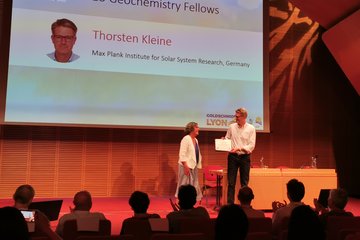Alle Typen
21.
Konferenzbeitrag
Energetic neutral atom imaging of the magnetosphere (in griech. In: Proc. Symp. Solar and Space Research, S. 560 - 566 (Hg. Anagnostopoulos, G. C.). Demokritos University of Thrace, Xanthi (1994)
22.
Konferenzbeitrag
Imaging of the magnetosphere via energetic neutral atoms. In: Proc. 2nd Symp. on Solar and Space Research, S. 560 - 566, (Hg. Anagnostopoulos, G. C.). Democritus University of Thrace, Xanthi (1994)
23.
Konferenzbeitrag
Coupling of the high-latitude and the equatorial magnetosphere during substorms through the transport/acceleration of ionospheric ions. In: Substorms 2, Proc. 2. Int. Conf. on Substorms, Fairbanks, S. 615 - 619 (Hg. Kan, J. R.; Craven, J. D.; Akasofu, S.-I.). Univ. of Alaska, Fairbanks (1994)
24.
Konferenzbeitrag
LET-2 experiment: A spectrum analyzer for energetic charged particles 20 keV-2 MeV (in griech. Sprache). In: Proc. Symp. Solar and Space Research, S. 553 - 559 (Hg. Anagnostopoulos, G. C.). Demokritos University of Thrace, Xanthi (1994)
25.
Konferenzbeitrag
Proposal of an Italien experiment for the mission SAC-B. ISENA: Imaging Particle Spectrometer for energetic neutral atoms, Instrumentation for magnetospheric imagery. In: SPIE, S. 91 - 101. Society of Photo-Optical Instrumentation Engineers, Washington (1992)
26.
Konferenzbeitrag
Proposal of an Italian experiment for the mission SAC-B. ISENA: Imaging particle spectrometer for energetic neutral atoms. In: ISENA. ESA Publ. Div., Noordwijk (1992)
27.
Bericht
Remote sensing of the Earth's magnetosphere: An instrument for energetic neutral atoms based on time-of-flight and solid state detector. Istituto di Fisica dello Spazio Interplanetario, Frascati/Italy (1995)
28.
Bericht
The ring current system as derived from AMPTE-CCE/CHEM data; comparison with the simulated ENA once mapped back into the magnetosphere. Istituto di Fisica dello Spazio Interplanetario, Frascati (1994)
29.
Bericht
ENA simulation at low altitude: A feedback technique to reconstruct the originating ion spectra and source location. Istituto di Fisica dello Spazio Interplanetario, Frascati (1994)











